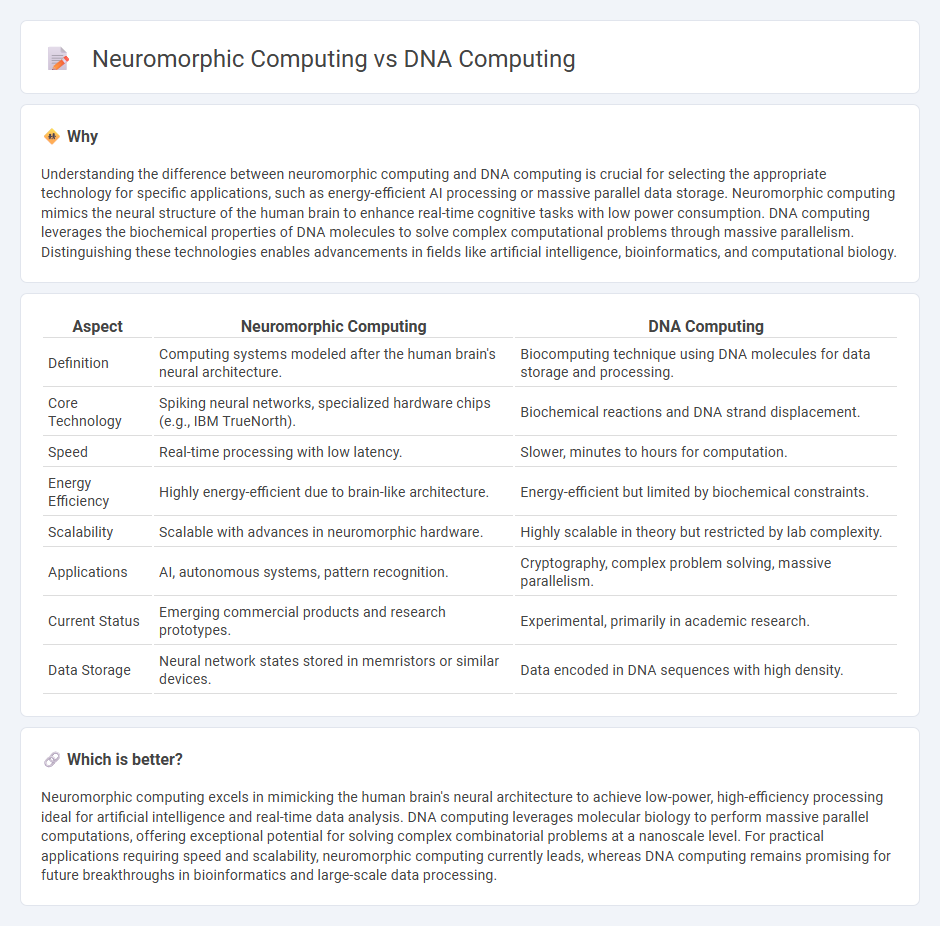
Neuromorphic computing replicates the neural structure and functioning of the human brain using artificial neurons and synapses, enabling highly efficient processing for tasks like pattern recognition and sensory data interpretation. DNA computing leverages the biochemical properties of DNA molecules to perform complex computations at a molecular level, offering massive parallelism and potential breakthroughs in solving combinatorial problems. Explore the unique advantages and future potentials of neuromorphic and DNA computing technologies to understand their impact on next-generation processing paradigms.
Why it is important
Understanding the difference between neuromorphic computing and DNA computing is crucial for selecting the appropriate technology for specific applications, such as energy-efficient AI processing or massive parallel data storage. Neuromorphic computing mimics the neural structure of the human brain to enhance real-time cognitive tasks with low power consumption. DNA computing leverages the biochemical properties of DNA molecules to solve complex computational problems through massive parallelism. Distinguishing these technologies enables advancements in fields like artificial intelligence, bioinformatics, and computational biology.
Comparison Table
| Aspect | Neuromorphic Computing | DNA Computing |
|---|---|---|
| Definition | Computing systems modeled after the human brain's neural architecture. | Biocomputing technique using DNA molecules for data storage and processing. |
| Core Technology | Spiking neural networks, specialized hardware chips (e.g., IBM TrueNorth). | Biochemical reactions and DNA strand displacement. |
| Speed | Real-time processing with low latency. | Slower, minutes to hours for computation. |
| Energy Efficiency | Highly energy-efficient due to brain-like architecture. | Energy-efficient but limited by biochemical constraints. |
| Scalability | Scalable with advances in neuromorphic hardware. | Highly scalable in theory but restricted by lab complexity. |
| Applications | AI, autonomous systems, pattern recognition. | Cryptography, complex problem solving, massive parallelism. |
| Current Status | Emerging commercial products and research prototypes. | Experimental, primarily in academic research. |
| Data Storage | Neural network states stored in memristors or similar devices. | Data encoded in DNA sequences with high density. |
Which is better?
Neuromorphic computing excels in mimicking the human brain's neural architecture to achieve low-power, high-efficiency processing ideal for artificial intelligence and real-time data analysis. DNA computing leverages molecular biology to perform massive parallel computations, offering exceptional potential for solving complex combinatorial problems at a nanoscale level. For practical applications requiring speed and scalability, neuromorphic computing currently leads, whereas DNA computing remains promising for future breakthroughs in bioinformatics and large-scale data processing.
Connection
Neuromorphic computing and DNA computing both leverage biological principles to enhance computational efficiency and adaptability. Neuromorphic computing models neural architectures using silicon circuits to mimic brain-like processing, while DNA computing exploits molecular reactions for parallel data processing and storage. Their connection lies in using nature-inspired mechanisms to overcome limitations of traditional silicon-based computing and enable advanced problem-solving capabilities.
Key Terms
Biomolecular Operations (DNA computing)
DNA computing leverages biomolecular operations such as hybridization, ligation, and strand displacement to perform complex parallel processing and information storage within DNA molecules, enabling massive scalability at a molecular level. Neuromorphic computing, on the other hand, mimics neural architectures in hardware to optimize energy efficiency and speed but relies on electronic components rather than biochemical reactions. Explore the intricate mechanisms and potential applications of biomolecular operations in DNA computing to uncover new frontiers in bio-inspired computation.
Spiking Neural Networks (neuromorphic computing)
DNA computing leverages biological molecules to perform parallel computations through biochemical reactions, excelling in solving combinatorial and optimization problems at a molecular scale. Neuromorphic computing, particularly using Spiking Neural Networks (SNNs), mimics brain-like information processing by encoding data with spikes over time, enabling energy-efficient event-driven computation ideal for sensory and real-time tasks. Explore further the comparative advantages and emerging applications of DNA computing and SNN-based neuromorphic architectures.
Parallelism
DNA computing harnesses massive parallelism through molecular reactions where numerous DNA strands simultaneously process information, enabling the execution of complex computations at a biochemical level. Neuromorphic computing mimics neural architectures, utilizing parallel processing capabilities inherent in networks of artificial neurons to achieve energy-efficient and highly responsive computations. Explore further to understand how these paradigms revolutionize parallelism across computing disciplines.
Source and External Links
DNA computing - DNA computing is an unconventional form of computing that uses DNA, biochemistry, and molecular biology hardware instead of traditional silicon chips, enabling massively parallel operations and potentially solving complex problems by encoding information in the four DNA nucleobases (A, T, C, G).
The DNA computer: super hard drive of the future? - DNA computing proposes replacing binary data encoding with a four-symbol code (A, T, C, G), offering vastly superior data storage density, long-term stability, and energy-efficient archiving with the potential to last thousands of years without energy input.
For First Time, DNA Tech Offers Both Data Storage and Computing - Recent advances have enabled a functional DNA computer that can repeatedly store, retrieve, compute, erase, and rewrite data, mimicking the full range of operations possible in traditional electronic devices and dramatically increasing storage capacity in a compact, durable format.
 dowidth.com
dowidth.com